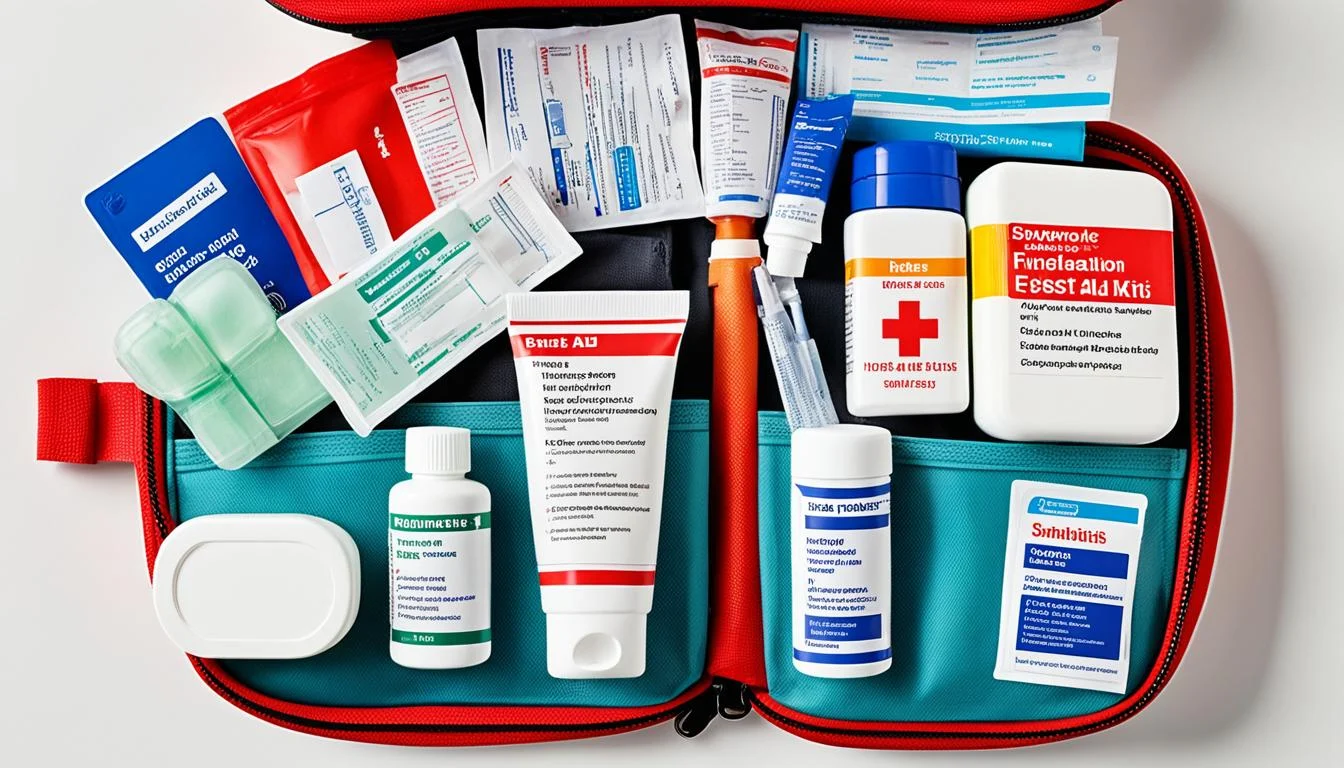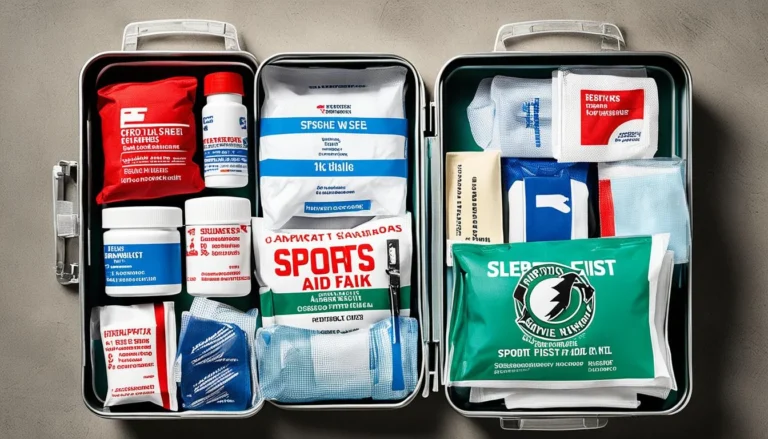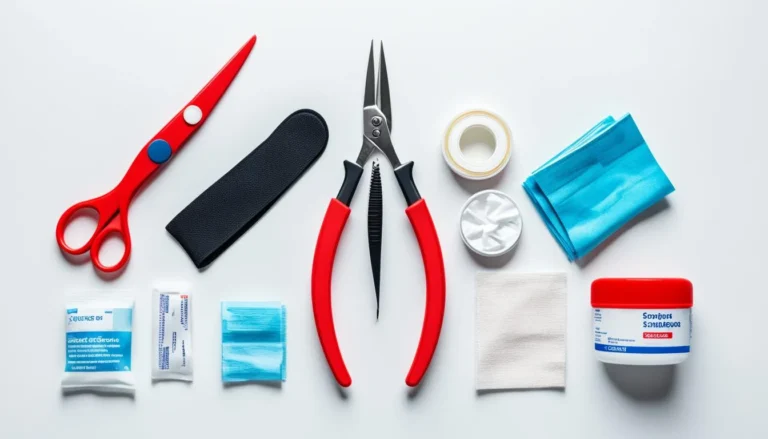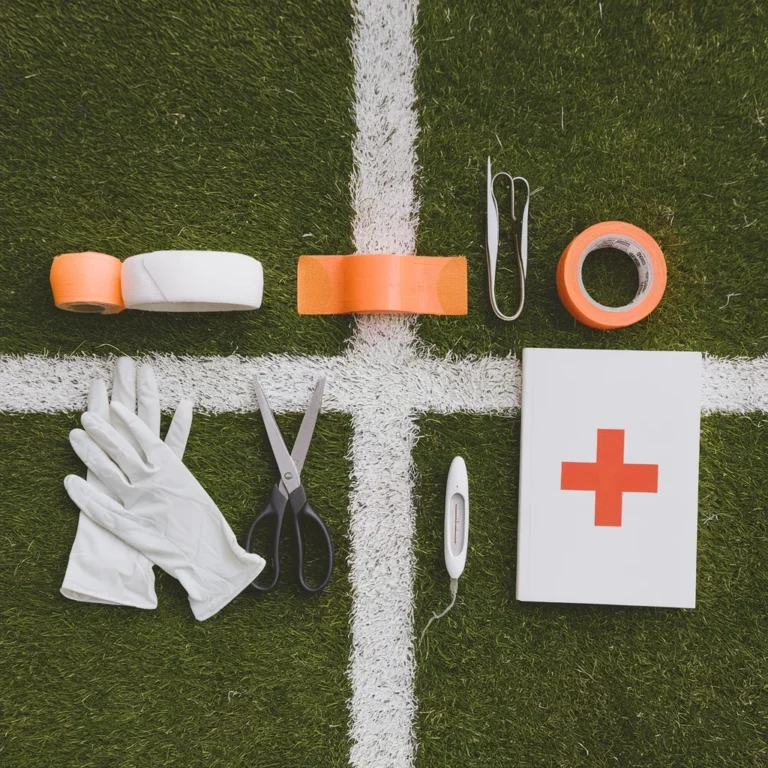Avoid These Items in UK First Aid Kits
When you prepare for emergencies in the UK, a first aid kit is key. But it’s not just about what you put in. You also need to know what to leave out. Some items might look helpful but can be unsafe for your UK emergency preparedness.
There are certain unsafe first aid supplies to avoid. The reasons can be legal issues, the chance of misuse, or they could cause accidents. It’s vital to know these to keep your first aid kit safe and within the law.
Key TakeawaysWhat should not be in a first aid kit in the UK
- Understanding what to exclude is crucial for a safe and legal UK first aid kit.
- Misuse of prohibited items can lead to legal complications and safety issues.
- Ensure your first aid supplies meet the evolving medical treatment standards.
- Medications and needles are among the items that should not be included.
- A well-conceived first aid kit focuses on essential items, excluding potentially harmful substances.
- Knowing what to omit is as vital as knowing what to include for emergency preparedness.
Understanding the Importance of a Properly Stocked UK First Aid Kit
A well-stocked first aid kit is crucial for handling emergencies. It holds life-saving equipment and essential medical supplies. This allows for quick emergency treatment, helping avoid serious problems. A good kit follows first aid compliance and cuts risks of improper first aid supplies. This means people can manage health crises well.
The Essential Role of First Aid Kits in Emergencies
Having a full first aid kit is key when emergencies happen. Being ready reduces emergency complications. It gives the injured initial care until expert help arrives. Thus, kits aren’t just tools but represent being prepared and offering quick care.
Dangers of Incorrect First Aid Kit Contents
Wrong items in first aid kits can be dangerous. This exposes people to risks of misuse. Using outdated or wrong items, like expired medicines, can make things worse. It turns a manageable situation into a serious problem.
The Impact of Misusing Medical Supplies
Using wrong items from a first aid kit has serious effects. It raises risks of misuse and can cause many medical and legal issues. This happens if untrained people try to give help. Thus, knowing how to use the kit right and the dangers of doing it wrong is key. It’s closely linked to how well emergency help will work.
| First Aid Supply | Correct Use | Potential Risks of Misuse |
|---|---|---|
| Antiseptic Wipes | Cleaning around wounds to prevent infection | Applying directly to open wounds may cause irritation |
| Adhesive Bandages | Miniaturised wounds covering to keep clean | Using on infected wounds without proper cleansing may trap bacteria |
| Elastic Bandages | Supporting sprains or strains | Incorrect application can lead to constriction and impaired circulation |
| Sterile Gloves | Protecting both the caregiver and receiver from infection | Reuse can spread contaminants and increase infection risk |
What Should Not Be in a First Aid Kit UK
When making a first aid kit in the UK, follow the UK legal guidelines for first aid kits. This makes sure you meet safety compliance. Not following the rules can lead to health risks and legal problems. Some items must not be in first aid kits because they can be harmful.
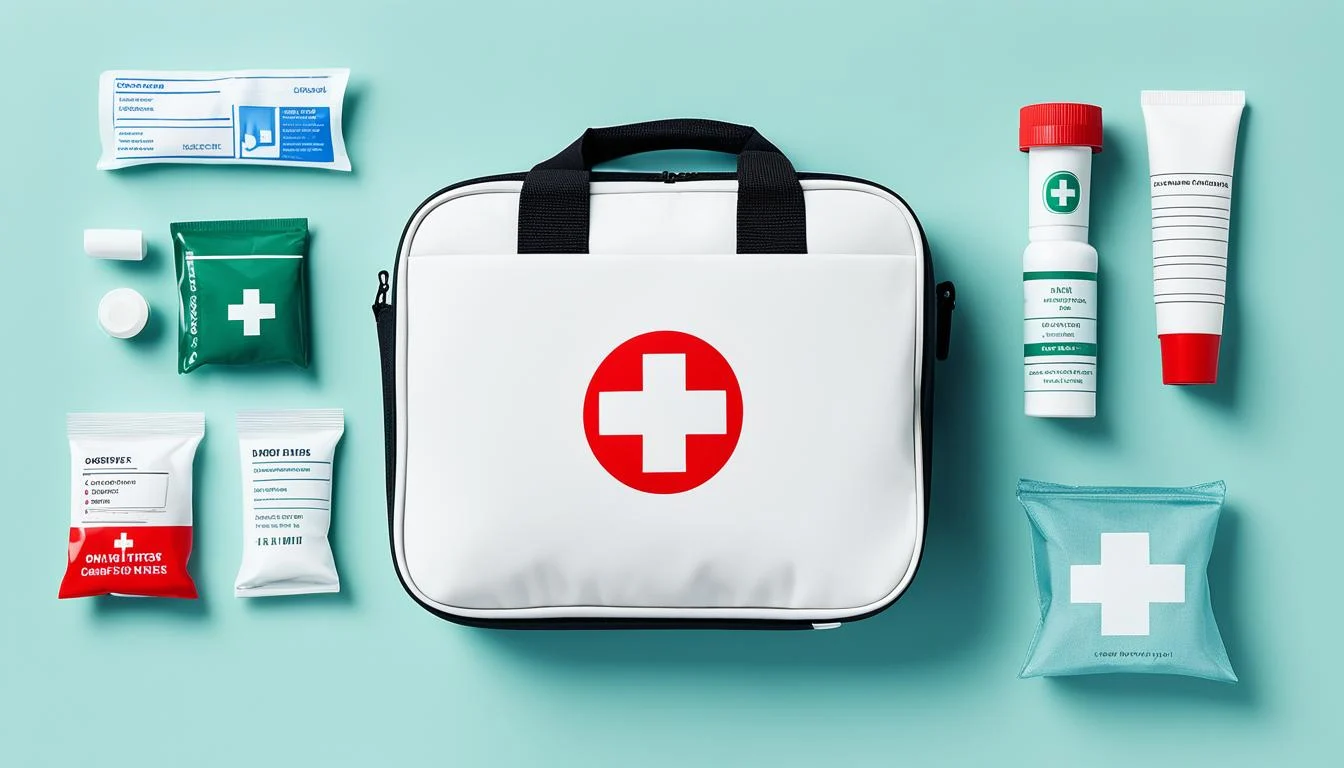
Medications are a no-go without proper training. They could cause allergies or other bad reactions. Sharp objects, like needles, are too risky. They could cause misuse or infection.
Keep out flammable things and cleaners such as bleach. They are bad for injuries and could make things worse. They could burn or harm eyes and open wounds. Keep these items out of all UK first aid kits for safety and to follow the law.
| Category | Examples | Reason for Exclusion |
|---|---|---|
| Medications | Painkillers, Antihistamines | Potential for misuse, allergic reactions |
| Sharps | Needles, Scalpels | Risk of injury, infection hazard |
| Inflammables | Alcohol solutions, Acetone | Burn risk, not for wound treatment |
| Harsh Chemicals | Bleach, Ammonia | Can cause burns, toxic if ingested |
The Legitimate Contents of a UK First Aid Kit
Making sure your workplace meets UK first aid rules is key. This means having a safe place to work. The Health and Safety (First-Aid) Regulations 1981 tell employers what they must do. The main goal is to keep employees well by having first aid ready.
Compulsory Items for Workplace First Aid Kits Under UK Regulations
The Health and Safety (First-Aid) Regulations 1981 say workplaces need certain items. These items are listed by the NHS for common injuries. They should match the risks of your work, helping to keep the workplace safe.
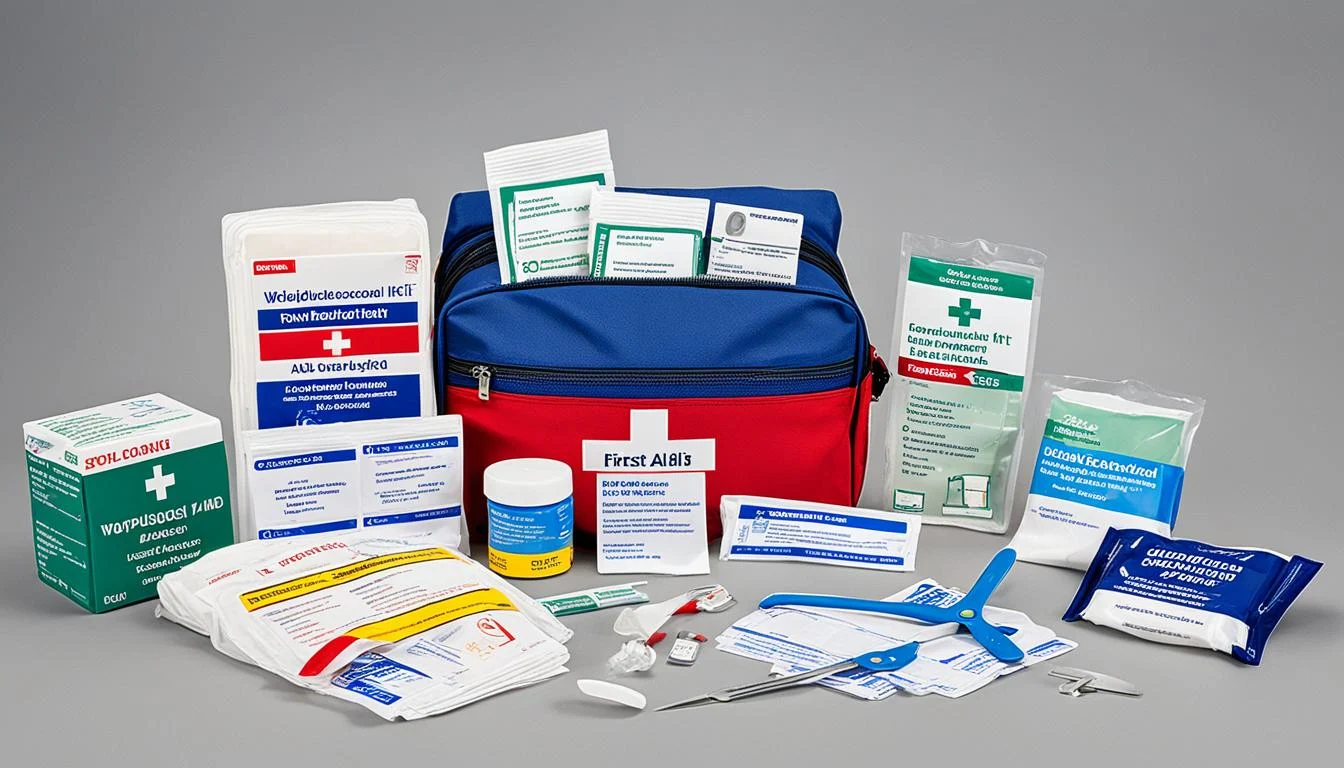
Perform a needs assessment to equip their first aid kits appropriately.
Here are the must-haves for first aid kits to meet the first aid kit standards and BS 8599-1:
| Item | Quantity (Minimum) | Purpose |
|---|---|---|
| Sterile Plasters | 40 | To cover small cuts and grazes |
| Sterile Dressings | 4 | To dress wounds, stop infections |
| Bandages | 12 | Helps with support, pressure on wounds |
| Disposable Gloves | 2 pairs | Keeps things clean, stops germs |
| Cleansing Wipes | 20 | Cleans skin around injuries |
Risks of Non-Compliance With British Standards BS 8599-1
Bosses can choose what’s in their first aid kits, but it must be right. Not following BS 8599-1 standards can cause big problems. This can harm worker safety and lead to legal trouble. It’s key to follow the safety rules.
Having the right kit can be crucial. It can help give the right help fast in an emergency. Knowing and following these rules shows we care about health and safety. It’s part of being ready for any emergency.
First Aid Kit Considerations for Special Circumstances
Going into the wild or looking after health far away makes remote area provisions key. Getting your first aid kit right is a must for safety. It’s vital when medical help could be hours away.
Those heading away from cities should add more to their customised medical kits. This includes not just the usual bandages and antiseptics but also special gear for remote places.
Add personal medicines to your kit if you have health issues. Keep these in their original packaging to avoid mix-ups. Make sure they’re clearly labelled for quick use in emergencies.
| Item | Standard First Aid Kit | Customised for Remote Area |
|---|---|---|
| Bandages | Assorted sizes | High durability and varied sizes |
| Antiseptics | Wipes and creams | Wipes, creams, and sterile solutions |
| Medications | Limited over-the-counter pain relievers | Prescribed medications, anti-venoms |
| Sterile Equipment | Basic | Advanced for handling trauma |
| Communication Tools | Not included | Satellite phones, GPS, distress signal devices |
While basic first aid kits work in the city,
exploring off the beaten track needs more preparation
. Having the right mix of
travel first aid guidelines
and
remote area provisions
means you’re ready to help until experts arrive.
Conclusion
First aid kit safety is very important for being ready in emergencies in the UK. Having a good first aid kit helps people deal with accidents quickly. It also meets health and legal rules. Knowing UK laws on first aid kits is vital.
Being ready in emergencies gets better when first aid kits are well-stocked. Checking these kits often is key to keep them up to date and ready. It’s smart to make the kits fit the needs of different places or health issues.
In the UK, being prepared for emergencies is crucial. We must all know and keep up our first aid kits. Learning and staying current on medical practices is part of this. With careful planning, we can all help make our society safer. Being ready to manage health emergencies should be natural for us all.

